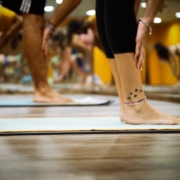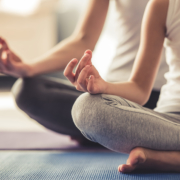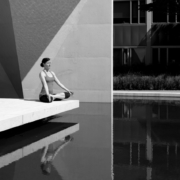Sequencing For Success: Tips For Yoga Teachers
I’m working in Victoria right now, teaching Part 2 of a three-part teacher training and some workshops. In the teacher training the students are at the point where they are designing and teaching 1 hour yoga classes to each other, which is always a lot of fun, and as I taught both a mixed level and an advanced workshop this week I have had sequencing on my mind. Creative sequencing has always been one of my favorite aspects of teaching yoga and I believe it is one of the most valuable tools we have to help our students learn asana (and so much more) in a fun, safe, and empowering way. I believe that a mindfully sequenced yoga class can help to establish a clear teaching environment in the classroom as the teaching objectives can be chosen ahead of time, and though the class you plan may need to be adapted somewhat based on who actually shows up, the very fact that you have walked in with a plan and an intention means that you are much more likely to offer something of real value, rather than simply leading your students through yet another repetition of what they are already familiar with. Now while I certainly don’t plan every single class I teach I do plan most of them, and especially when I have a specific pose or lesson I want my students to learn.
and some workshops. In the teacher training the students are at the point where they are designing and teaching 1 hour yoga classes to each other, which is always a lot of fun, and as I taught both a mixed level and an advanced workshop this week I have had sequencing on my mind. Creative sequencing has always been one of my favorite aspects of teaching yoga and I believe it is one of the most valuable tools we have to help our students learn asana (and so much more) in a fun, safe, and empowering way. I believe that a mindfully sequenced yoga class can help to establish a clear teaching environment in the classroom as the teaching objectives can be chosen ahead of time, and though the class you plan may need to be adapted somewhat based on who actually shows up, the very fact that you have walked in with a plan and an intention means that you are much more likely to offer something of real value, rather than simply leading your students through yet another repetition of what they are already familiar with. Now while I certainly don’t plan every single class I teach I do plan most of them, and especially when I have a specific pose or lesson I want my students to learn.
It has been my experience that when I take the time to plan out and sequence my classes in a mindful way then I am more able to –
- Support my students in gaining greater leverage into intermediate or advanced postures
- Teach principles of alignment and action that will empower their practice
- Give them tools to avoid common misalignments
- Establish a mood for practice such as Clarity, Celebration, or Mindfulness
- Help them embody inspiring philosophical teachings or practical wisdom
So how can you use sequencing as a skilful tool to deepen your students learning experience in the classroom? Here are some things that I have found helpful and that I train my yoga teacher trainees to think about.
Things To Think About When Planning Your Classes
When sitting down to plan your classes ask yourself the following questions to help in planning a class that is suitable to your student base and has a clear focus.
- Who am I planning this class for?
- What is the general level of the students attending this class?
- What is my primary intention with this class?
- What am I trying to teach?
- What do I want the students to walk away with?
- How long is the class?
- What style is the class?
- What time of day/year is it?
3 Primary Doorways for Choosing Class Sequences
There are many doorways into class planning but I have found that one of three primary entry points are most useful in planning my classes and they are.
- Moving towards a peak pose
- Based around an alignment principle
- Inspired by a philosophical or heart based theme
While some of your classes may have all three of these primary elements in them picking one as a framework to get started with is helpful. Below are some tips for each category.
Tips on Sequencing to a Peak Pose
Sequencing to a peak pose means to choose a destination for the class, and to then build your class around how to get there safely and effectively, and how to get back. Students love the thrill of working towards a goal and they value learning something specific as well as being challenged to try something new. Below are some tips on sequencing to a peak pose.
- Pick a pose that is appropriate to the general level of the class
- The pose should be challenging, but not absolutely impossible, make sure that everyone has a stage of the final pose that they can work on so nobody is left out
- Take the time to really think about what will be needed to access the pose and then design a class that will enable your students to cultivate whatever that is, this way you are teaching them key actions and alignment principles rather than simply shapes of poses
- Build towards the pose in a logical and progressive way and always try to get there in the shortest time possible, while still ensuring that you have opened the key muscles groups needed, or taught the key actions that will allow them to do the peak pose
- Cut out all filler postures that don’t directly enable the opening required for the peak pose, be specific and efficient in your posture choices
- Make sure to leave enough time to do the appropriate counter poses in order to bring them back from the peak towards Savasana with a relaxed body and mind
Tips on Sequencing Around An Alignment Principle
Designing a class to highlight a key alignment principle, or to address a common misalignment, is a great teaching technique and really allows your students to get the lesson firmly in their bodies, and minds, through repetition and practice.
- Identify an alignment principle that will help your students to access greater ease, connection, or power in their practice
- Choose simple and familiar poses that will help them to learn the alignment principle clearly and explain it to them so they know what it is, and what it’s benefits are. Ex: in Tadasana instruct the proper placement of the feet and let them know that setting a good foundation will take care of 90% of the misalignment problems in the body of the pose and creates a grounded, mindful state of mind
- Weave in a few poses that are more challenging to maintain the alignment principle in, but which are greatly benefited by the principle itself Ex: doing Urdhva Danurasana without letting the foundation of the feet turn out or lift so as to avoid back pain, feel greater connection in the pose, and access more of a clear opening in the front body
- Make sure to repeat the action enough times, and in enough different types of postures in the class that the students understand it clearly- even if they can’t yet maintain it all of the time. This gives them something to work towards and they will remember the lesson in their bodies.
Tips on Sequencing Around a Theme
Sequencing to a philosophical or heart based theme can add a lot of power to your classes and though I could write an entire blog post about how to skillfully weave a theme into your class the primary things to think about once you have chosen a theme for class are-
- Once you have chosen an inspirational theme for your class try to distill your theme into one or two key words that represent the main lesson you want to impart and that you want your students to be able to embody or cultivate
- Now choose poses that will help your students to embody the theme, or the mood that you want to cultivate in class, and think about how you are going to sequence and instruct the poses so that your choices support your choice of theme
- Think about what breath exercises (pranayama), meditations, partner exercises, demonstrations, readings, or visualizations you might also want to include that will help support your theme
- And finally write down 3-4 instructions you might use in class that allow you to touch on your theme and even though you may not end up using the exact instructions you wrote down when you are actually teaching the class I’ve found it helpful to have thought about how I will deliver the theme ahead of time (and if you can’t think of 3-4 instructions with your theme choice than you should probably try a simpler theme!)
I hope that you find some of these suggestions helpful and that they may inspire you to plan your classes with more specificity. If you have questions about sequencing or want to share your insights please feel free to comment, as I love hearing from you.
Happy sequencing!













